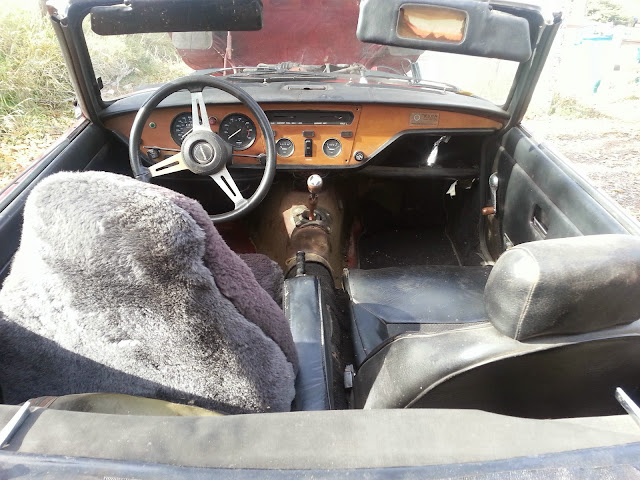One of the issues I face is the starter. Upon turning the key, we get plenty of spinning noise, but no engine rotation.
Clearly, the pinion gear was not engaging the ring on the flywheel. Or perhaps the gears were so badly stripped that it was spinning but not able to drive the motor around.
My options: replace the starter with a $50 Autozone special, pay through the nose for a rebuilt Lucas model, or, if no prior owner had gone the Autozone route before, attempt to rebuild the faulty original one myself. Since all of these options involve removing the bad starter first, that I did.
The process took all of 10 minutes. As somebody who spent far too many hours trying to work on a SAAB 9-5, the Spitfire engine access was heavenly.
Upon removal, it was clear that it was indeed the original Lucas model, and therefore unlike any starter I had ever touched before. It was also clear that the pinion gear was in fine shape, which was a relief.
As I understand it, modern starters use a solenoid to perform two tasks: to connect the heavy-gauge circuit that actually drives the starter motor, and to slide the pinion gear into contact with the ring gear. Well, this older design uses a separate solenoid to close the circuit, but relies on inertia and a helical grooved shaft to slide the pinion into place.
If the helical shaft is gummed up, the gear can refuse to make contact. And it appears that is my problem - the gear was not sliding freely on the helical shaft. This is good news, because it means I just saved $50 and learned something pretty cool, to boot.

I've always loved the intricate windings of electric motors, so I took it apart anyway. The interior of the starter looked pretty good. There wasn't any sign of damaged bushings or other trouble. So I left well enough alone and put it back together, hitting the helical shaft with a couple shots of WD-40 to loosen things up.
To be clear, this is a little half-assed. It's anyone's guess how long the starter's been in there, and I should at least be replacing the brushes & bushings inside just on principle. Some guys
go a bit further, cleaning or replacing everything and repainting the shell.
But getting to it is so easy, it doesn't seem like much of a missed opportunity to try it out now and pull it if there are problems down the road. And the motor has clearly been spinning, and sounding good while doing so -- it just hasn't been engaging the ring gear and turning the motor.
Besides, I'm trying hard not to fall down the rabbit hole of "perfect" right now -- my schedule and budget couldn't bear it. The short-term goal is to get the machine running and driving. Once that's done, I can make occasional improvements as time and money allow. And if it turns out I love the car and can track down some workshop space, well, maybe I'll attempt a more serious restoration in the future.










